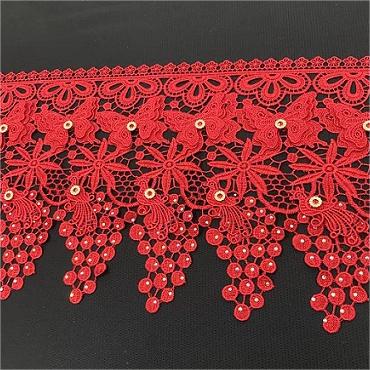What is Lace, and How is It Different from Other Types of Fabric?
2025-04-03
Lace is one of the most elegant and timeless textiles, often associated with sophistication, romance, and intricate craftsmanship. Unlike other fabrics, lace is distinguished by its delicate, openwork design, which creates intricate patterns and a sense of lightness. But what exactly is lace, and how does it stand apart from other fabrics? Let’s explore its unique characteristics, types, and differences from traditional textiles.
What is Lace?
Lace is a decorative fabric known for its open-weave structure, often featuring intricate floral, geometric, or ornamental patterns. It is usually made from materials like cotton, silk, linen, nylon, or polyester, depending on whether it is handmade or machine-made. Lace can be used in clothing, accessories, home décor, and even industrial applications, making it a highly versatile fabric.
The defining feature of lace is that it is not woven like traditional fabrics but rather created through looping, twisting, or knotting threads together to form patterns. This gives lace its characteristic delicate and airy look.

How is Lace Different from Other Types of Fabric?
Lace differs from other fabrics in several key ways:
1. Structure and Manufacturing Process
- Traditional fabrics (such as cotton, wool, silk, and polyester) are made by weaving or knitting fibers together in a structured pattern.
- Lace, on the other hand, is created through intricate methods such as bobbin lace-making, needle lace-making, or machine production, resulting in an open, mesh-like design.
2. Transparency and Openness
- Most fabrics have a solid surface, providing full coverage and opacity.
- Lace is semi-transparent or sheer due to its openwork design, allowing light to pass through its patterns.
3. Texture and Flexibility
- Woven fabrics typically have a smooth or textured surface based on the fiber composition.
- Lace has a distinct tactile quality, often feeling delicate, intricate, and slightly rough due to its pattern details.
4. Purpose and Usage
- Standard fabrics are primarily used for functional clothing (such as cotton for everyday wear or wool for warmth).
- Lace is predominantly used for decorative purposes, such as in wedding dresses, lingerie, curtains, and embellishments.
5. Durability and Maintenance
- Traditional fabrics, especially those made of durable fibers like denim or canvas, can withstand frequent washing and wear.
- Lace is often fragile and delicate, requiring careful handling, hand washing, or dry cleaning to maintain its shape and structure.
Types of Lace
Lace comes in various types, each with unique characteristics:
1. Chantilly Lace – A delicate lace with floral patterns, often used in bridal gowns and evening wear.
2. Venetian Lace – A heavy, luxurious lace with raised embroidery, perfect for formal attire.
3. Guipure Lace – A bold lace with thick, interwoven patterns, commonly used in modern fashion.
4. Bobbin Lace – Handmade lace created by twisting and braiding threads on bobbins.
5. Chemical Lace – Made by embroidering patterns onto a fabric base, then dissolving the base to leave only the lace.
6. Crochet Lace – A handmade lace created using a crochet hook, often seen in vintage designs.
Conclusion
Lace is a unique and artistic fabric that stands out due to its intricate patterns, airy structure, and decorative appeal. Unlike traditional woven or knitted fabrics, lace is designed more for aesthetics than functionality, making it a staple in fashion, home décor, and art. Its timeless elegance and versatility continue to make it a sought-after fabric in modern and historical designs.
Whether used as a delicate trim or the main fabric in a garment, lace remains a symbol of refinement, romance, and craftsmanship.


